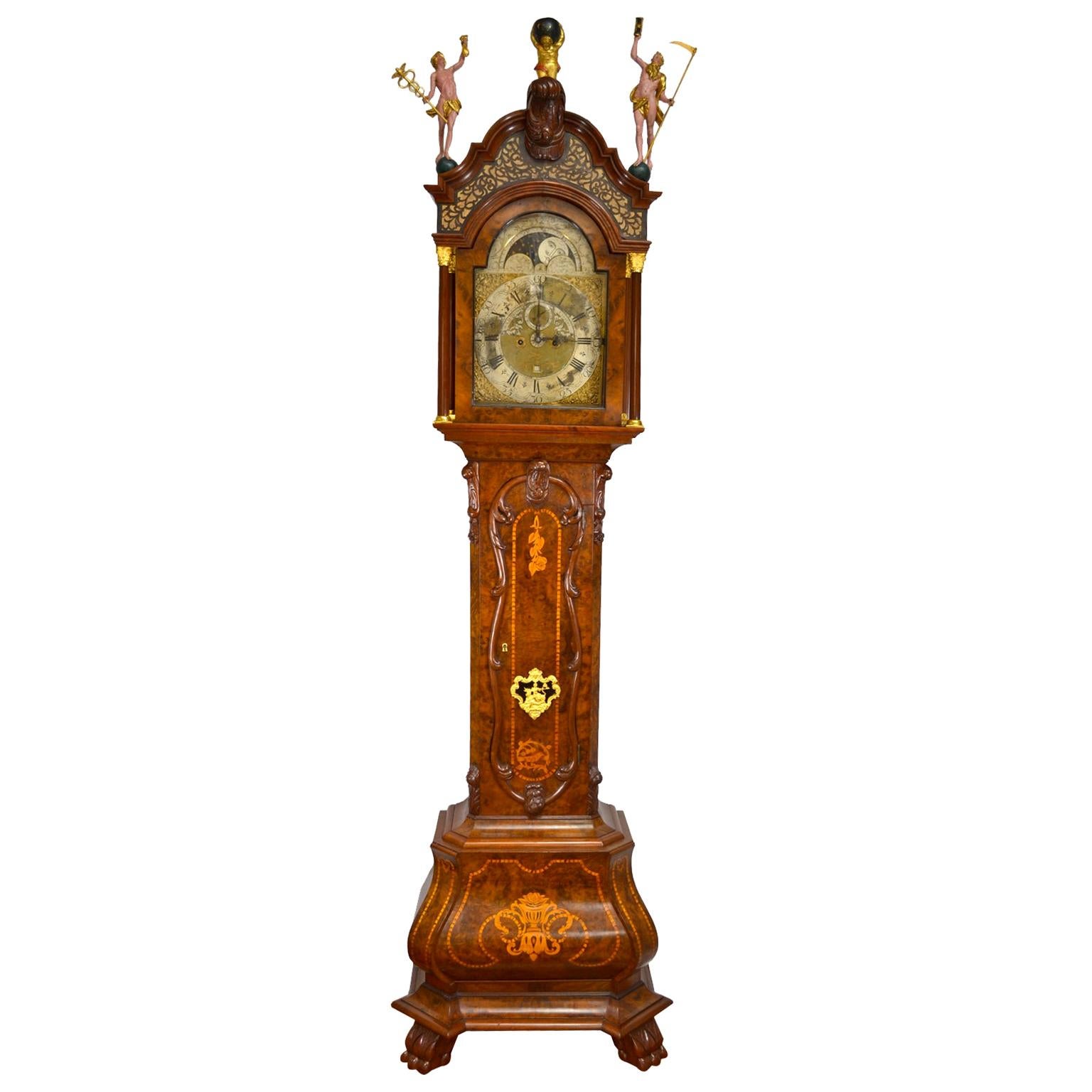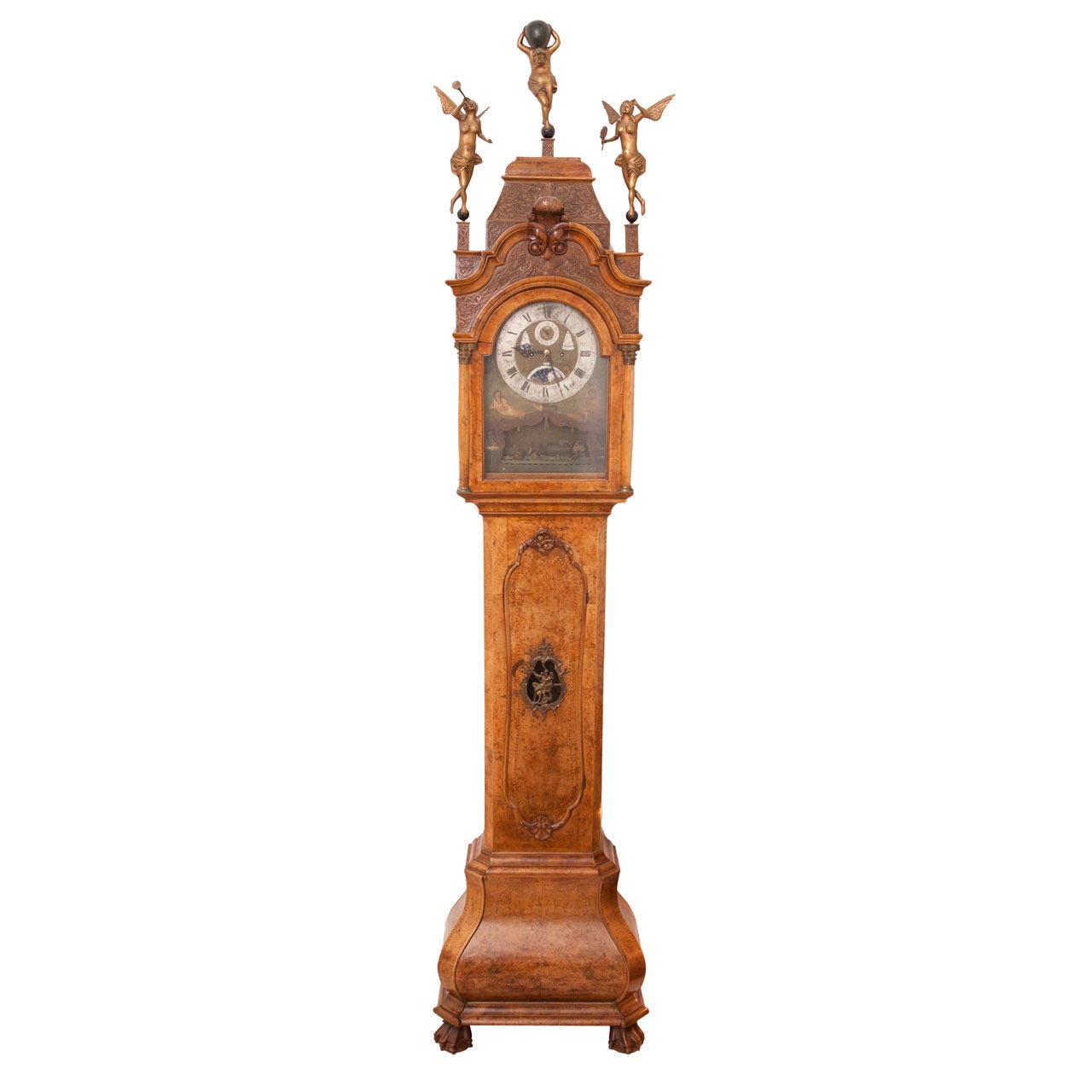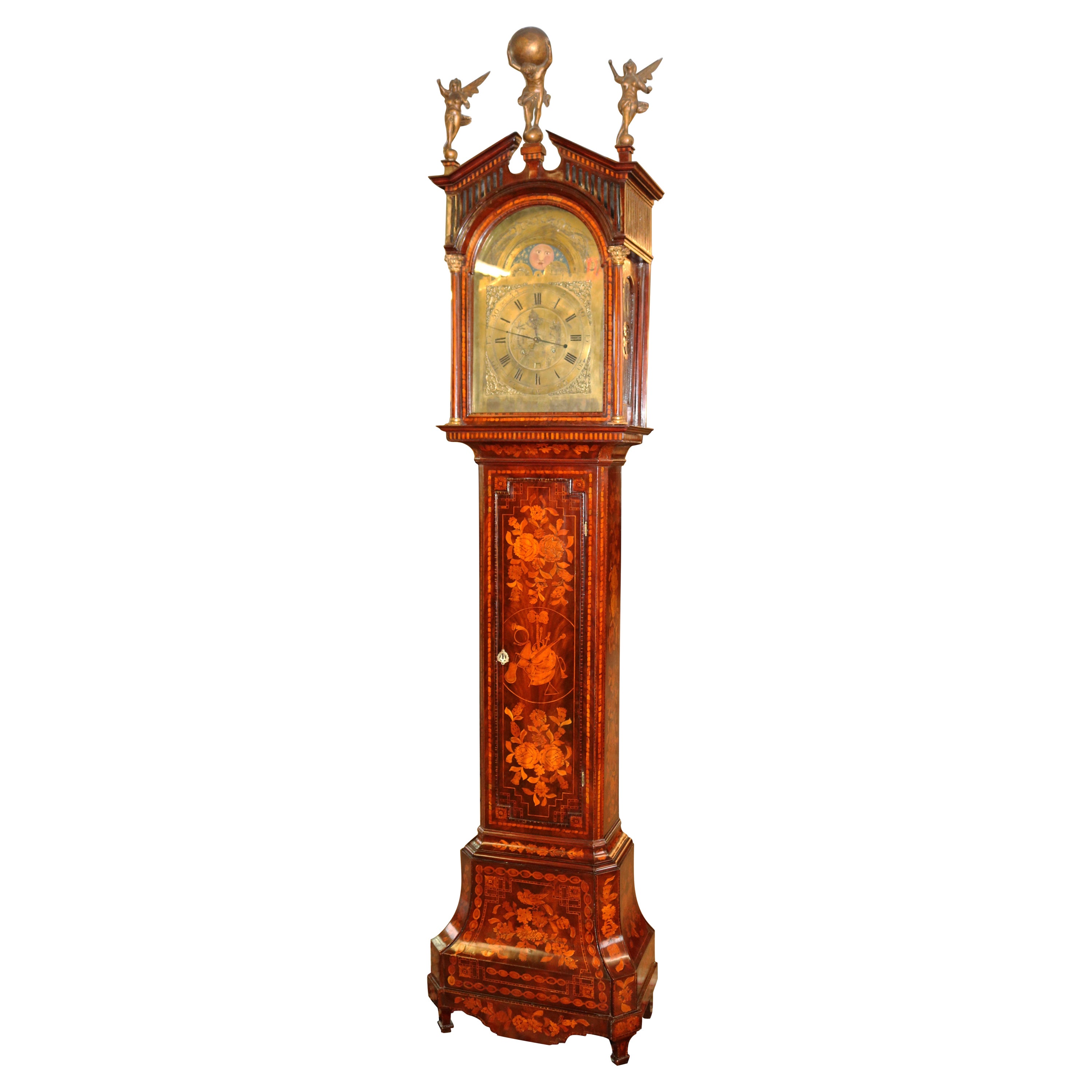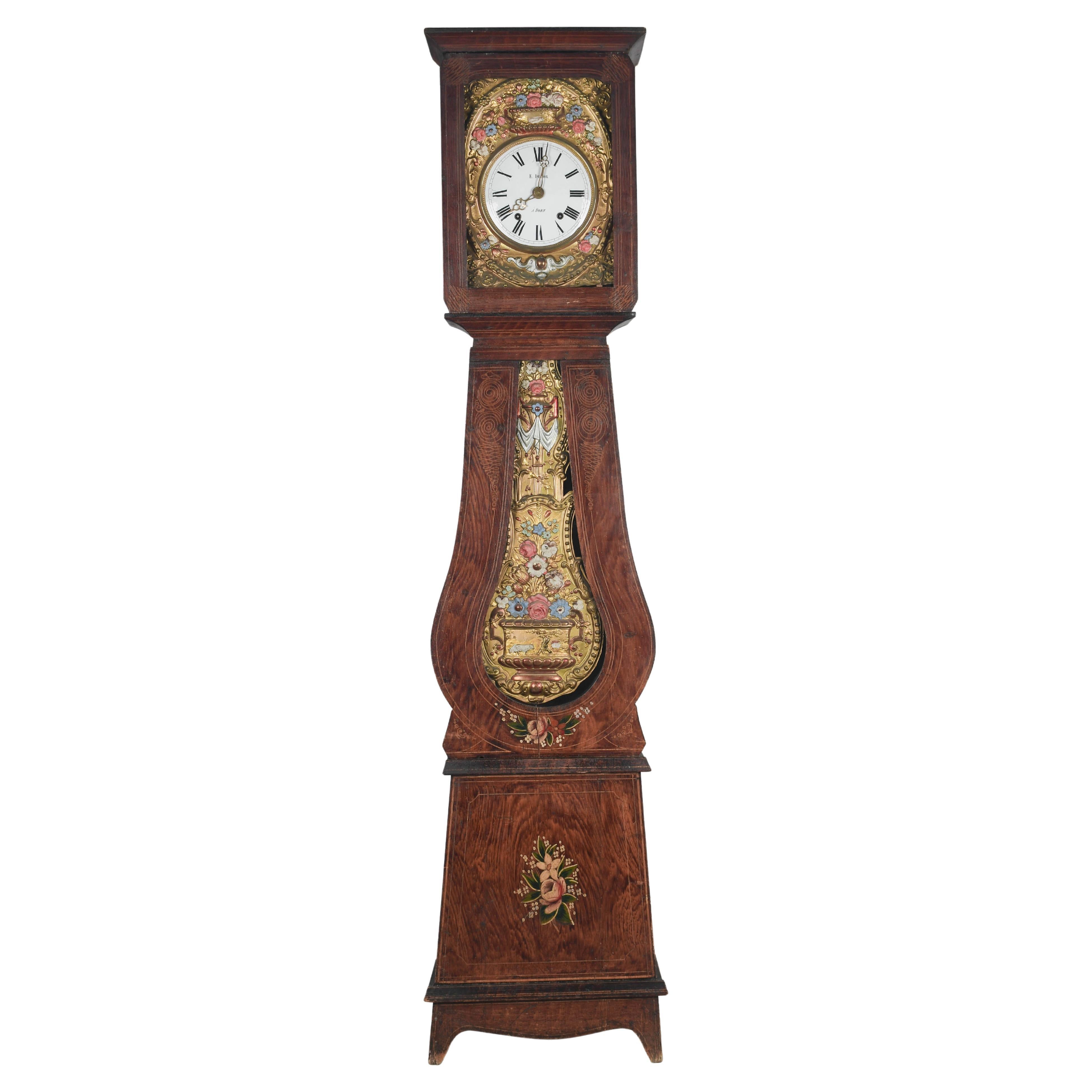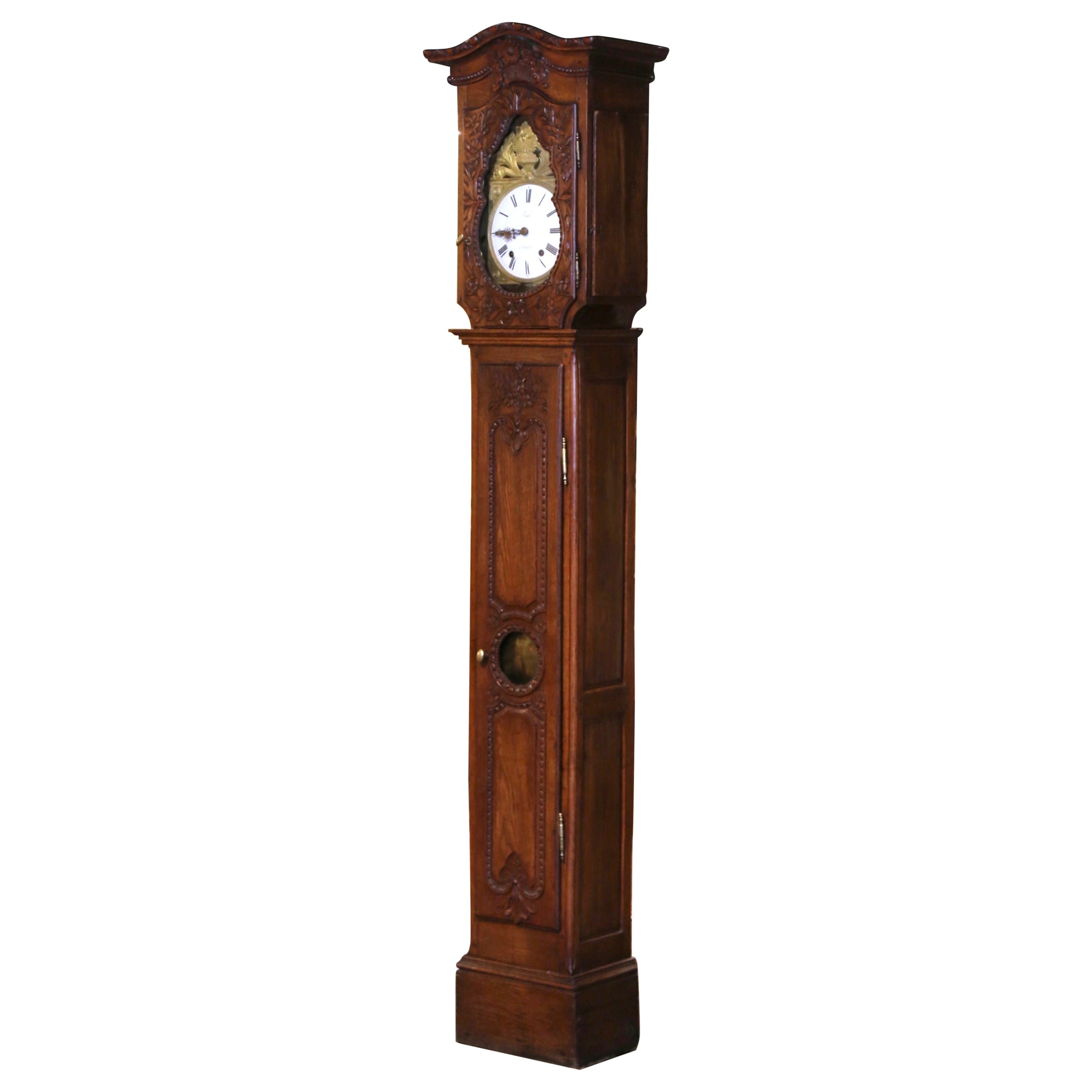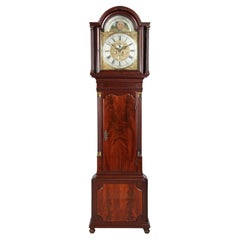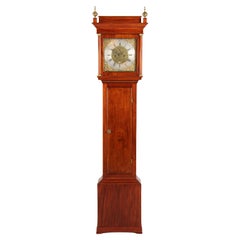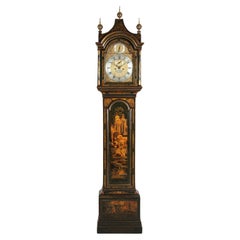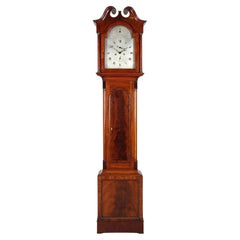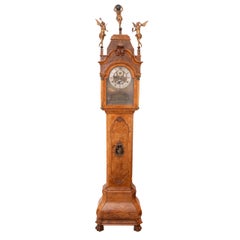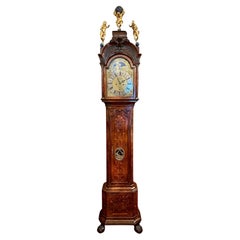Objekte ähnlich wie 18th Century Dutch Grandfather Clock, Calendar and Moonphases, Amsterdam 1760-70
Video wird geladen …
Möchten Sie mehr Bilder oder Videos?
Zusätzliche Bilder oder Videos von dem*der Anbieter*in anfordern
1 von 21
18th Century Dutch Grandfather Clock, Calendar and Moonphases, Amsterdam 1760-70
15.500 €Einschließlich MwSt.
Angaben zum Objekt
Antique Amsterdam grandfather clock with alarm, calendar and moon phase
Amsterdam
Walnut root and others
circa 1760
Dimensions:
H x W x D: 283 x 58 x 30 cm - without figures the height is reduced to 241 cm
Description:
Elaborate grandfather clock in typical Amsterdam design with figure crowning.
The walnut-root veneered body with fine maple inlays stands on so-called ball-and-claw feet, which were particularly popular in the mid-18th century. The lower part of the body is, also typical of the time, strongly bulging, while the centre part is recessed in width and has a curved door at the top and bottom with thread inlays following this line. The asymmetrical, ormolu framing of the viewing window with its C-curves, flowers and rocailles corresponds to the formal language of the Rococo period.
The head of the clock is spectacular. The round arch supported by four columns with openwork above is complemented by a pedestal-like structure with carved and oil-gilt figures. On the left we see Hermes, the messenger of the gods, here as the patron saint of trade with a quill and purse; and on the right Fama, the goddess of fame with the Roman tuba in her hand. And enthroned above all this is Atlas, the Titan, holding the celestial globe.
A very similar case, with a clockwork by Otto van Meurs, is described in Jan Zeeman - De Nederlandse Staande Klok on pages 126-128. (See photo) It reads as follows:
Otto van Meurs had a particularly skilful case maker, distinguished by his refined workmanship and the beautiful colour of the walnut veneer. The inlay work on the double-curved base of the clock dates from this period. The moulded part on the pendulum window clearly shows that an elegant and playful interplay of lines was a basic requirement at this time.
It is obvious that the case of the clock on offer here comes from the workshop of this very case maker.
The dial is also particularly interesting. The moon phase and the age of the moon can be seen at the top of the arch. The fact that the moon is firmly mounted and the celestial disc rotates in front of it is unusual and therefore particularly noteworthy. This is a rare design which, in contrast to the usual rotating moon, still leaves space to the left and right of the arch. This space was used for a fine painting:
Against the expanse of the sky and in the shade of the trees, we see on the left hand side Spes, the personification of hope, leaning on an anchor and ensuring a good harvest; and on the right, Caritas as the personification of charity, here mercifully caring for the family.
Below this is a silver-plated chapter ring with black Roman numerals for the hours and Arabic numerals for the minutes, which are rotated from 20-40, typical of the time and region. The finely sawn and blued steel hands run in front of a small silver ring, which is used to set the alarm time.
Below this, we see the day of the week in a triangular window with the corresponding Greek symbol and a personification of a deity, in this case Chronos, who stands for Saturday and who limits life with his scythe. The other days of the week are symbolised by Diana, the goddess of the hunt on Monday; Ares, the god of war and battle on Tuesday; Hermes, the messenger of the gods on Wednesday; Zeus, the highest of all gods on Thursday; Venus, the goddess of love and beauty on Friday; and Apollo, the god of music and beautiful things on Sunday.
Above the winding holes we see a small sub-dial for the seconds, a window for the date and the signature of the master clockmaker - Jan Storm - Amsterdam.
The Storm family is recorded with several generations of clockmakers in Amsterdam from 1672. According to Enrico Morpurgo - Nederlandse klokken- en horlogemakers vanaf 1300, Jan Storm was active from 1717. The clock offered here probably dates from the last years of his workshop.
The weight-driven movement, with a power reserve of one week, strikes the number of hours on the half-hour and hour, and a single strike for each quarter hour.
Condition:
Very good, restored condition of movement and case. The movement has been completely dismantled, cleaned and overhauled, the case has been primed with shellac and matted with wax.
The top pedestal of the head was not present at the time of purchase and was added during the restoration according to the old model. On the photo showing the back wall of the case, you can see that the back wall was first shortened and then lengthened again, presumably for transport during a move.
We recommend the following literature for this clock:
Jan Zeeman - De Nederlandse Staande Klok
You can find out more about the creative period of the Storm clockmaking family in the following directory:
Enrico Morpurgo - Nederlandse klokken- en horlogemakers vanaf 1300
- Maße:Höhe: 283 cm (111,42 in)Breite: 58 cm (22,84 in)Tiefe: 30 cm (11,82 in)
- Stil:Louis XV. (Aus dem Zeitalter)
- Materialien und Methoden:
- Herkunftsort:
- Zeitalter:1760–1769
- Herstellungsjahr:1760-1770
- Zustand:Ersetzungen vorgenommen: The top pedestal of the head was not present at the time of purchase and was added during the restoration according to the old model. On the photo showing the back wall of the case, you can see that the back wall was first shortened and then lengthen. Abnutzung dem Alter und der Nutzung entsprechend. Very good, restored condition of movement and case. The movement has been completely dismantled, cleaned and overhauled, the case has been primed with shellac and matted with wax.
- Anbieterstandort:Greven, DE
- Referenznummer:1stDibs: LU5419245432442
Anbieterinformationen
4,9
Platin-Anbieter*in
Premium-Anbieter*innen mit einer Bewertung über 4,7 und 24 Stunden Reaktionszeit
Gründungsjahr 2014
1stDibs-Anbieter*in seit 2020
196 Verkäufe auf 1stDibs
Typische Antwortzeit: 1 Stunde
- VersandAngebot wird abgerufen …Versand von: Münster, Deutschland
- Rückgabebedingungen
Einige Inhalte dieser Seite wurden automatisch übersetzt. Daher kann 1stDibs nicht die Richtigkeit der Übersetzungen garantieren. Englisch ist die Standardsprache dieser Website.
Authentizitätsgarantie
Im unwahrscheinlichen Fall eines Problems mit der Echtheit eines Objekts kontaktieren Sie uns bitte innerhalb von 1 Jahr für eine volle Rückerstattung. DetailsGeld-Zurück-Garantie
Wenn Ihr Objekt nicht der Beschreibung entspricht, beim Transport beschädigt wurde oder nicht ankommt, kontaktieren Sie uns bitte innerhalb von 7 Tagen für eine vollständige Rückerstattung. DetailsStornierung innerhalb von 24 Stunden
Sie können Ihren Kauf jederzeit innerhalb von 24 Stunden stornieren, ohne jegliche Gründe dafür angeben zu müssen.Geprüfte Anbieter*innen
Unsere Anbieter*innen unterliegen strengen Dienstleistungs- und Qualitätsstandards, wodurch wir die Seriosität unserer Angebote gewährleisten können.Preisgarantie
Wenn Sie feststellen, dass ein*e Anbieter*in dasselbe Objekt anderswo zu einem niedrigeren Preis anbietet, werden wir den Preis entsprechend anpassen.Zuverlässige weltweite Lieferung
Unsere erstklassigen Versandunternehmen bieten spezielle Versandoptionen weltweit, einschließlich individueller Lieferung.Mehr von diesem*dieser Anbieter*in
Alle anzeigenEnglische Standuhr des späten 18. Jahrhunderts mit Mondphasen, Manchester, um 1780
Englische Großvateruhr mit Mondphasen aus dem späten 18.
England (Manchester)
Mahagoni
zweite Hälfte des 18. Jahrhunderts
Abmessungen: H x B x T: 209 x 56 x 25 cm
Beschreibung:
Be...
Kategorie
Antik, Spätes 18. Jahrhundert, Englisch, Standuhren
Materialien
Mahagoni
Englische Großvateruhr aus dem 18. Jahrhundert von James Pike
Antike Standuhr von George III. aus Newton Abbot
England (Newton Abbot)
Mahagoni
um 1790
Abmessungen: H x B x T: 207 x 50 x 27 cm
Beschreibung:
Ein auf einem Sockel stehendes Gehä...
Kategorie
Antik, Spätes 18. Jahrhundert, Britisch, Standuhren
Materialien
Messing
Chinoiserie-Großvateruhr, England, London, Mitte des 18. Jahrhunderts, Standuhr
Von James Scholefield
Chinoiserie Standuhr
England (London)
Eiche lackiert
Mitte des 18. Jahrhunderts
Abmessungen: H × B × T: 236 × 48 × 24 cm
Beschreibung:
Antike englische Standuhr mit feinem Lackdek...
Kategorie
Antik, Mitte des 18. Jahrhunderts, Britisch, Chinoiserie, Standuhren
Materialien
Eichenholz
Schottische Standuhr, hergestellt von William Spark, Aberdeen, um 1820
Standuhr George III mit versilbertem Zifferblatt
Schottland (Aberdeen)
Mahagoni
Georg III. um 1820
Abmessungen: H x B x T: 222 x 47 x 23 cm
Beschreibung:
Schöne antike schottische...
Kategorie
Antik, 1820er, Schottisch, George III., Standuhren
Materialien
Mahagoni
Englische Standuhr aus der Mitte des 19. Jahrhunderts mit bemaltem rundem Zifferblatt
Antike englische Standuhr mit gemaltem Zifferblatt im Mahagonigehäuse
Das Gehäuse steht auf kleinen runden Füßen und hat einen breiten unteren Teil, darüber einen schmaleren Teil mi...
Kategorie
Antik, Mittleres 19. Jahrhundert, Britisch, Standuhren
Materialien
Mahagoni
19. Jahrhundert Kaminsimsuhr "Astronomie", Frankreich um 1830
Antike Kaminsimsuhr zum Thema Astronomie
Frankreich
Bronze
Karl X. um 1830
Abmessungen: H x B x T: 48 x 19 x 10 cm
Beschreibung:
Außergewöhnliche und schön gearbeitete Bronze-Kami...
Kategorie
Antik, 19. Jahrhundert, Französisch, Charles X., Tisch- und Schreibtisch...
Materialien
Bronze
Das könnte Ihnen auch gefallen
Holländische 'Utrecht' Stand- oder Großvateruhr des 18. Jahrhunderts von W.V. Dadelbeek
Von W.V. Dadelbeek
Eine holländische Standuhr aus Nussbaum, Wurzelholz und Intarsien von W.V Dadelbeek, Utrecht. Das Gehäuse in typischer Form, Kofferraumtür mit Federbändern, Bombensockel, originale g...
Kategorie
Antik, Mitte des 18. Jahrhunderts, Niederländisch, Louis XV., Standuhren
Materialien
Walnuss
Amsterdamer Standuhr, signiert Pieter Verlaer, um 1840-1860
Amsterdamer Uhr mit hohem Gehäuse.
Signiert Pieter Verlaer,
Niederländisch, ca. 1840-1860.
Nussbaum und Nussbaum mit Noppen.
Die Uhr hat ein erstaunliches...
Kategorie
Antik, 19. Jahrhundert, Niederländisch, Neurokoko, Uhren
Materialien
Walnuss
Holländische Großvateruhr mit figuralen Intarsien aus dem späten 18.
Diese prächtige Standuhr wurde Ende des 18. Jahrhunderts in den Niederlanden hergestellt. Das Gehäuse ist mit prächtigen Intarsien versehen, und auf der Oberseite der Haube befinden ...
Kategorie
Antik, Spätes 18. Jahrhundert, Niederländisch, Niederländisch Kolonial, ...
Materialien
Messing
Antike niederländische Intarsienuhr „Pieter Paulus“ Amsterdamer Großvater, um 1730.
Antike holländische Intarsien-Großvateruhr, Zifferblatt und Uhrwerk von Pieter Paulus, Amsterdam, CIRCA 1720-1740.
Kategorie
Antik, Frühes 18. Jahrhundert, Niederländisch, Standuhren
Materialien
Seidenholz, Walnuss
Französische Comtoise-Grandfather-Uhr aus dem 19. Jahrhundert
Eine französische Standuhr aus dem 19. Jahrhundert mit polychrom lackiertem Kieferngehäuse und geprägtem Messingpendel. Sieben-Tage-Morbier-Uhrwerk, professionell gereinigt und funkt...
Kategorie
Antik, 19. Jahrhundert, Französisch, Französische Provence, Standuhren
Materialien
Messing, Emaille
Große geschnitzte Eichenholz-Etuiuhr aus der Normandie, Louis XV.-Periode, 18. Jahrhundert
Diese elegante, antike Standuhr wurde um 1780 in der Normandie, Frankreich, hergestellt. Die große Standuhr steht auf einem geraden Sockel; sie hat eine geschwungene Haube über einem...
Kategorie
Antik, Mitte des 18. Jahrhunderts, Französisch, Louis XV., Standuhren
Materialien
Eichenholz
